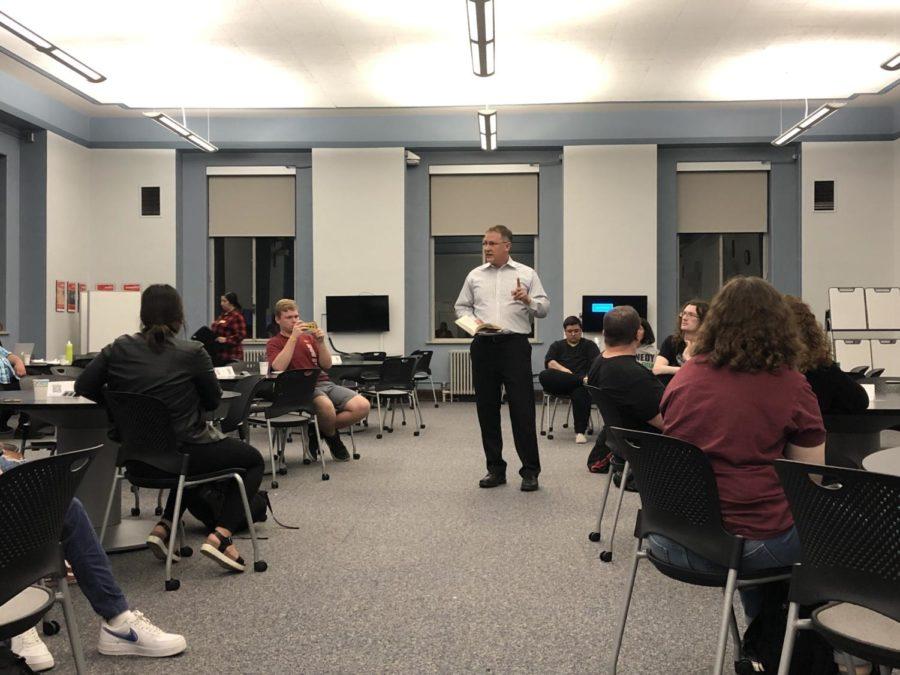Latinx film screening focuses on Texas school segregation
Logan Metzger/ Iowa State Daily
Brian Behnken, associate professor for history, leads the discussion after the film showing of “Stolen Education” by Enrique Aleman.
September 26, 2019
After the Brown v. Board of Education case was decided, not every school wanted to comply and rural Texas schools found ways to segregate Mexican-American students other than separate buildings.
As part of Latinx Heritage Month, Parks Library is presenting four films pertaining to the Latinx experience in the United States. The second film, “Stolen Education” was shown on Thursday to a room of over 15 people.
The film centers on Enrique Alemán Jr., associate professor of educational leadership and policy at the University of Utah. Alemán traveled around Texas seeking out how Mexican-American school children were treated after the Brown v. Board of Education case, specifically in Driscoll, Texas where he was raised and where his mother went through the segregated school system.
In 1954, Brown v. Board of Education of Topeka was decided and the U.S. Supreme Court ruled American state laws establishing racial segregation in public schools are unconstitutional, even if the segregated schools were otherwise equal in quality.
The film said not every school conformed to this federal mandate or found ways to segregate children in every way but name, without calling it “segregation.”
One of those ways was to keep students back or to separate them into other classes on the basis of their language, IQ or their culture, stating Mexican-American students were not “American” enough to be in the same classroom as white students.
Specifically in the Driscoll school district, along with many other southern school districts at the time, Mexican-American students were held back systematically. Mexican-American children had to take first grade for three consecutive years in order to move onto second grade, starting in beginner first grade, then low first grade and finally high first grade. According to the film, Mexican-American students were forced down this track based solely on their racial identity, not their academic ability.
Many teachers at the school, who were all white and mostly women, and the school board, who were all white and mostly male farmers, excused this, reasoning the children were Hispanic and spoke Spanish and could not learn as fast as white, English-speaking children.
This system had long-lasting effects on the children. Many students dropped out or moved schools after being in first grade for three years. Of those who remained, many were 20 to 21 years old by the time they graduated from high school, often way older than their white peers.
“I was so embarrassed,” said Consuelo Esparza in the film, a student who graduated from Driscoll. “When I walked down the hallway I was asked where the office was by new students because I looked like a teacher.”
According to the film, the Driscoll school district did more than just force Mexican-American students to take three years of first grade, they also harshly punished the students for speaking Spanish.
In the film, former students from the Driscoll school district described how they were punished for speaking Spanish. They were often yelled at by teachers telling them “no Spanish,” while other times they were swatted on the back of the hand with rulers. Some were taken to the superintendent’s office, “Mr. Green,” and told to bend over before being paddled repeatedly. While out at recess white students were encouraged to turn in Mexican-American students if they heard them speak Spanish.
“It’s not like I could turn it off, it’s part of who I am,” said one woman in the film while describing how she and other classmates were lined up at the front of the room and swatted three times on the arm for speaking Spanish in class.
As a result of this, many of the Mexican-American children who went through this stopped speaking Spanish at home and never taught their children or grandchildren how to speak Spanish because they didn’t want future generations to go through what they did. One woman in the film said the lack of language knowledge has created deep guilt among Mexican-American youth who feel disconnected from their culture.
In 1957 the American G.I. Forum, a Hispanic veterans and civil rights organization, filed suit against the Driscoll Consolidated Independent School District (CISD) for segregation.
The case charged that the Driscoll CISD had developed and used a system of “beginners’ classes” for the first scholastic year, then for the next three years — “low first,” “high first,” and a segregated second grade — without testing all students. Proof of racial bias in the system was the placement of Linda Pérez in the “Mexican” first grade to learn English. In fact, she spoke no other language besides English.
The court found the Driscoll grouping of separate classes arbitrary and unreasonable, as it was directed against all children of Mexican origin as a class, and ordered the practice halted.
Although the decision prohibited the segregation of Mexican-American students in public schools, however, the system did not change radically and subsequent challenges became necessary. By the late 1960s the G.I. Forum filed more lawsuits challenging the lack of equal educational opportunity for Mexican-Americans.
After the film, there was a discussion among attendees facilitated by Brian Behnken, associate professor of history.
Behnken discussed how the system was made to make the Mexican-American students so uncomfortable they would leave.
“After being in first grade for three years they left,” Behnken said. “It’s called push out, you weren’t dropping out, you were being pushed out of the schools. That was the intent, they wanted to make it as uncomfortable for you so that you would leave.”
The next film screening in the series will take place at 6 p.m. on Oct. 3 in Parks Library room 198.
















